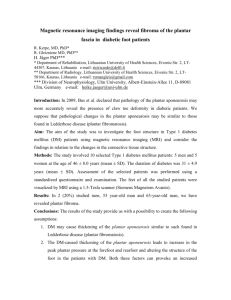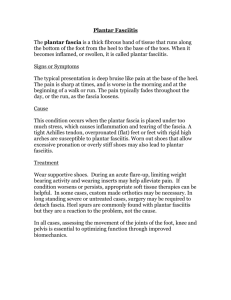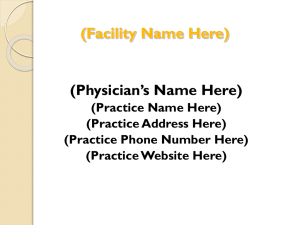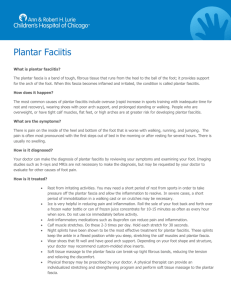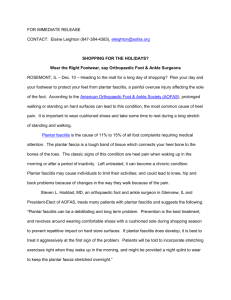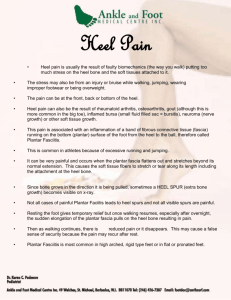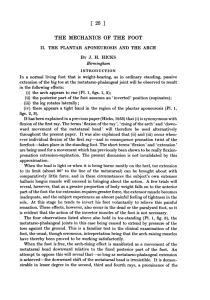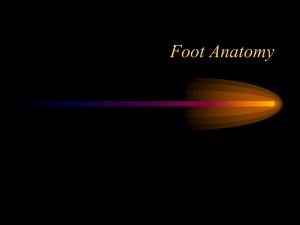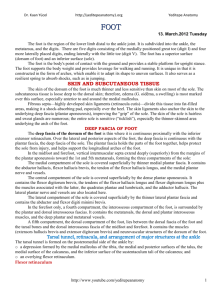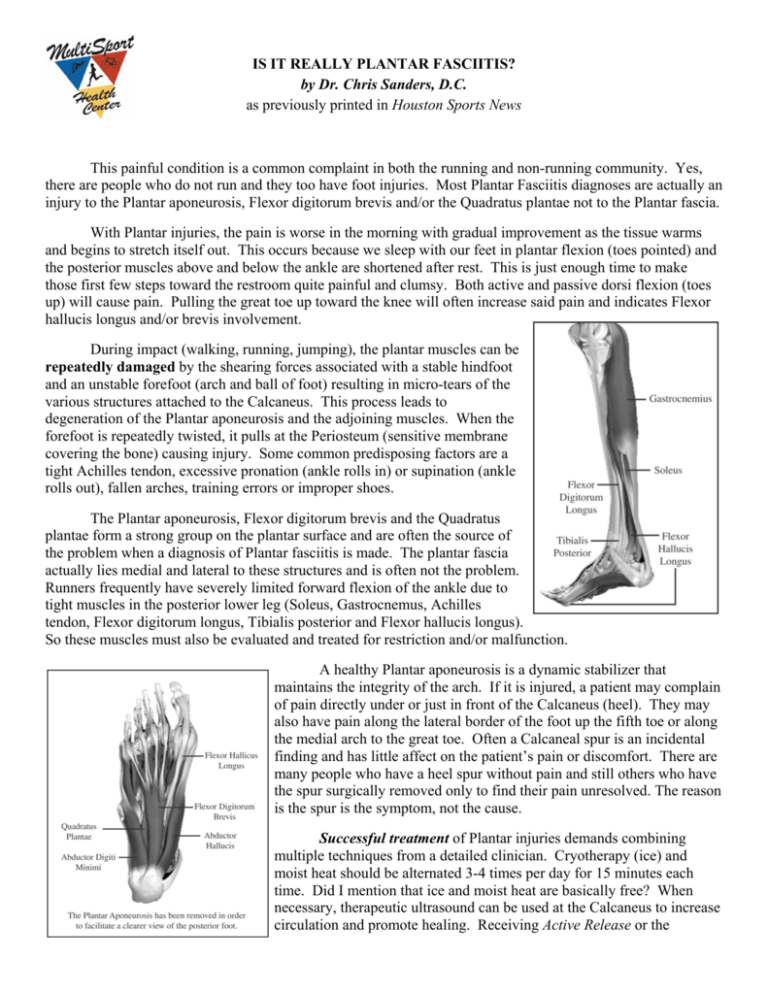
IS IT REALLY PLANTAR FASCIITIS?
by Dr. Chris Sanders, D.C.
as previously printed in Houston Sports News
This painful condition is a common complaint in both the running and non-running community. Yes,
there are people who do not run and they too have foot injuries. Most Plantar Fasciitis diagnoses are actually an
injury to the Plantar aponeurosis, Flexor digitorum brevis and/or the Quadratus plantae not to the Plantar fascia.
With Plantar injuries, the pain is worse in the morning with gradual improvement as the tissue warms
and begins to stretch itself out. This occurs because we sleep with our feet in plantar flexion (toes pointed) and
the posterior muscles above and below the ankle are shortened after rest. This is just enough time to make
those first few steps toward the restroom quite painful and clumsy. Both active and passive dorsi flexion (toes
up) will cause pain. Pulling the great toe up toward the knee will often increase said pain and indicates Flexor
hallucis longus and/or brevis involvement.
During impact (walking, running, jumping), the plantar muscles can be
repeatedly damaged by the shearing forces associated with a stable hindfoot
and an unstable forefoot (arch and ball of foot) resulting in micro-tears of the
various structures attached to the Calcaneus. This process leads to
degeneration of the Plantar aponeurosis and the adjoining muscles. When the
forefoot is repeatedly twisted, it pulls at the Periosteum (sensitive membrane
covering the bone) causing injury. Some common predisposing factors are a
tight Achilles tendon, excessive pronation (ankle rolls in) or supination (ankle
rolls out), fallen arches, training errors or improper shoes.
The Plantar aponeurosis, Flexor digitorum brevis and the Quadratus
plantae form a strong group on the plantar surface and are often the source of
the problem when a diagnosis of Plantar fasciitis is made. The plantar fascia
actually lies medial and lateral to these structures and is often not the problem.
Runners frequently have severely limited forward flexion of the ankle due to
tight muscles in the posterior lower leg (Soleus, Gastrocnemus, Achilles
tendon, Flexor digitorum longus, Tibialis posterior and Flexor hallucis longus).
So these muscles must also be evaluated and treated for restriction and/or malfunction.
A healthy Plantar aponeurosis is a dynamic stabilizer that
maintains the integrity of the arch. If it is injured, a patient may complain
of pain directly under or just in front of the Calcaneus (heel). They may
also have pain along the lateral border of the foot up the fifth toe or along
the medial arch to the great toe. Often a Calcaneal spur is an incidental
finding and has little affect on the patient’s pain or discomfort. There are
many people who have a heel spur without pain and still others who have
the spur surgically removed only to find their pain unresolved. The reason
is the spur is the symptom, not the cause.
Successful treatment of Plantar injuries demands combining
multiple techniques from a detailed clinician. Cryotherapy (ice) and
moist heat should be alternated 3-4 times per day for 15 minutes each
time. Did I mention that ice and moist heat are basically free? When
necessary, therapeutic ultrasound can be used at the Calcaneus to increase
circulation and promote healing. Receiving Active Release or the
Graston Technique by a certified provider, who will look at the kinetic chain of muscles which directly and
indirectly affect the function of the ankle and foot, can be very effective treatments. This is where the
clinician’s knowledge of anatomy and biomechanics will greatly enhance the patient’s prognosis.
Dynamic rehabilitation must also occur as part of an effective treatment plan. Treatment without
functionally strengthening an injured area will only facilitate a relapse and the continuation of a downward
cycle. The following courses of rehabilitation are just a sampling of what areas need to be addressed:
1. The intrinsic muscles of the foot itself must be strengthened. Our foot functions just like the paw in an
animal. The toes are supposed to provide traction and assist in pulling the body forward hence generating
speed. One strengthening exercise is to do exaggerated push off strides in the sand or in a pool. Weighted
towel scrunches using the toes can also strengthen these muscles.
2. The muscles of the anterior lower leg must be strengthened to give the ankle full range of motion. This can
be done by walking on your heels with the toes elevated and turned slightly outward for an isometric
contraction. Continue for multiple sets of 2 minutes. This will force the muscles of the posterior lower leg to
lengthen due to post-isometric relaxation. Also performing sitting or standing toe ups at various speeds
focusing on pulling the toes up helps strengthen the lower leg.
3. Dynamic stabilization exercises should be performed using a balance board or stability cushion. These
should begin two legged and progress toward one legged balancing postures emphasizing plantar and dorsi
flexion, supination and pronation. The arms should be progressively added to the motion to simulate a normal
running motion.
4. Cross-train with aqua jogging, cycling and the elliptical trainer provided you have no increase in pain or
reduced range of motion in your foot or ankle. This will help keep you fit while reducing the shearing impact
on your foot that occurs during running. When you have no pain in your foot upon waking, walking or crosstraining, you are ready to resume running or other impact activities.
5. If the forefoot can not be stabilized due to an intrinsic foot dysfunction orthotics should be considered. I
recommend Footmaxx.com as the best orthotics on the market. Footmaxx is the only system in the world that
allows digital gait and pressure analysis data to translate into a diagnostic report as well as a prescription for
custom orthotics. Each shoe and sport specific (over a dozen) orthotic is designed to stabilize the foot allowing
it to maximize the foot’s biomechanical movement, while also increasing the comfort and performance level of
the wearer. It also comes with a 30 day money back guarantee which is unheard of in the orthotic industry. I
have had great success using these orthotics to treat the source of the plantar injuries in combination with the
previously described treatments.
Plantar injuries can be debilitating if left untreated. Even if you have never suffered from one, you
should properly train your feet to counteract the high impact stresses of our daily lives. Ladies, also try to avoid
wearing high heeled shoes as this facilitates the shortening of the lower leg muscles. If you have a Plantar
injury, hopefully this article gets you back on the road to recovery.
Dr. Chris Sanders, D.C.
Clinical Director of MultiSport Health Center. Certified ART® Instructor & Provider of the
Upper Extremity, Spine, Lower Extremity, Biomechanics and Nerve Entrapment. Certified
Graston Technique Provider. For more information, visit www.multisporthealthcenter.com
or call 713/572-4100.
© 2007, Dr. Chris Sanders and MultiSport Health Center, Inc. All photos copyrighted by Billye Jo Sanders and MultiSport Health Center Inc. No part of this article
may be reproduced without expressed written consent from MultiSport Health Center, Inc. All brand and product names are registered trademarks, trademarks or
servicemarks of their respective holders and are gratefully acknowledged. All rights reserved.

